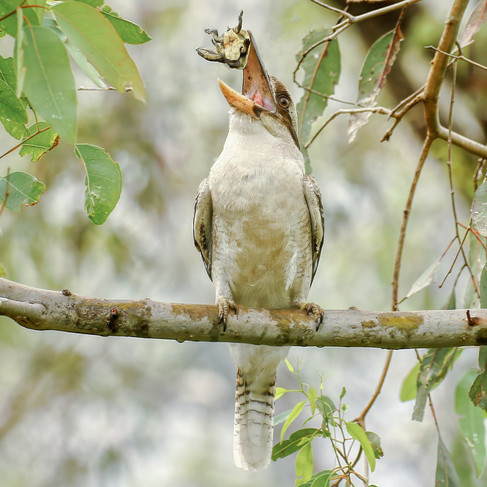Back to Nature - Conflicts
- Ronalyn

- Oct 15, 2024
- 2 min read
by Jamie Walker
Wild creatures are constantly attended by anxiety and tension – forces which support an essential energy that preserves their lives. This same energy drives many of their responses – enabling them to react to predators or rivals, seek mates or new food sources, migrate in due season and avoid our fearsome presence.
A good example of this responsive behaviour is the mobbing harassment of predators like pythons, owls or soaring birds of prey. When this occurs, birds of different species, which otherwise have no special interest in one another, unite in a loud, nagging assault intended to discomfit the victim and make it move on.
I have watched Shrike-thrushes, Honeyeaters, Scrub Wrens and Thornbills surround a roosting Boobook Owl. These tormentors recognise each other’s alarm calls, join forces and pursue the same end – the owl’s departure. Once this has been achieved, peace returns.
A Wedge-tailed Eagle soaring high, often shares its airspace with Magpies or Butcherbirds. These make aggressive passes and feints at the eagle, while holding back from coming too close to an apex predator.
Smaller raptors also mob larger ones (Peregrines seem to do it just for fun). Yet here’s a remarkable thing – birds seem to know that, although they are raptors, Ospreys only eat fish, so they are left in peace. They may still, however, be robbed of their catches by White-bellied Sea Eagles and it’s hard not to feel anthropomorphic empathy when we see ‘the bullies’ triumph.
The same feelings are difficult to resist if we witness predation. Kookaburras are impactive predators – eggs, chicks and many small animals are on their menu. I once saw a Kookaburra despatch a 25cm Marsh Snake on our backyard picnic table. The little reptile struggled to the very end as it was crushed in a powerful beak. At such moments, however impartial and nonchalant we see ourselves; we may well be moved.
A few months after that event, I found an incident taking place by the side of a Maleny footpath. Another Kookaburra was struggling in the coils of a smart looking Green Tree Snake. I surmised that this bird had also attacked the snake and bitten off more than it could chew. (Aggression the other way around is too improbable).
The serpent had been quick and clever. It had thrown coils around the bird’s beak and body in a way that pinned its wings back. I believe the contest had been progressing for some time, because the Kookaburra’s efforts were weakening. As all fight finally went out of the bird, the snake unwrapped and adroitly slipped away into the vegetation in a single lithe movement, leaving a gasping, dishevelled opponent to recover.
It was fear-driven energy that helped the snake; the force that drove its reaction to danger and saved its life: and perhaps honed the self-preservation experience of one Kookaburra as well. These small dramas are around us all the time.
Recent Posts
See AllWe are happy to announce the seventh year of the HINTERLAND TIMES YOUNG WRITER OF THE YEAR For 2025, the subject is…. AI or REALITY?...
Set in one of the most iconic parts of the Sunshine Coast Hinterland and a stone's throw from the beloved Kondalilla Falls, Kondalilla...
























Comments